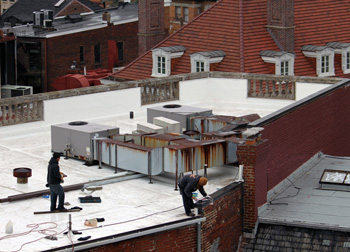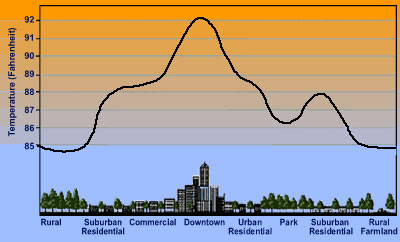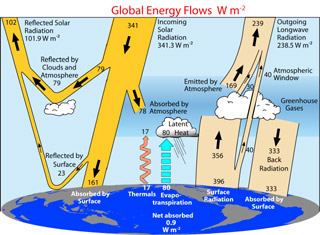Click on image for full size
Courtesy of Maria Jose-Vinas, American Geophysical Union
White Roofs May Successfully Cool Cities
News story originally written on January 28, 2010
Painting the roofs of buildings white has the potential to significantly cool off cities and mitigate some impacts of global warming, results of a new study indicate.
The research, the first computer modeling study to simulate the impacts of white roofs on urban areas worldwide, suggests there may be merit to the idea of turning roofs white.
But the study team, led by scientists at the National Center for Atmospheric Research (NCAR) in Boulder, Colo., cautions that there are still many hurdles between the concept and actual use of white roofs to counteract rising temperatures.
"Our research demonstrates that white roofs, at least in theory, can be an effective method for reducing urban heat," says NCAR scientist Keith Oleson, the lead scientist on the study. "It remains to be seen if it's actually feasible for cities to paint their roofs white, but the idea certainly warrants further investigation."
Results of the research are slated for publication later this winter in the American Geophysical Union (AGU) journal Geophysical Research Letters.
The work was funded by the National Science Foundation (NSF), NCAR's sponsor. "Climate change mitigation research is an extremely important topic," says Steve Nelson, NSF program director for NCAR. "Whether on white roofs or other climate change mitigation subjects, it's important to consider the many feedbacks and complicating considerations that make research in this area very complex."
Cities are particularly vulnerable to climate change because they are warmer than outlying rural areas.
Asphalt roads, tar roofs and other artificial surfaces absorb heat from the sun, creating an urban "heat island effect" that can raise temperatures on average by 2-5 degrees Fahrenheit (about 1-3 degrees Celsius) or more, compared to rural areas.
White roofs would reflect some of that heat back into space and cool temperatures, much as wearing a white shirt on a sunny day can be cooler than wearing a dark shirt.
The study team used a newly developed computer model to simulate the amount of solar radiation that is absorbed or reflected by urban surfaces.
The model simulations, which provide scientists with an idealized view of different types of cities around the world, indicate that, if every roof were entirely painted white, the urban heat island effect could be reduced by 33 percent.
This would cool the world's cities by an average of about 0.7 F, with the cooling influence being particularly pronounced during the day, especially in summer.
The authors emphasize that their research should be viewed as a hypothetical look at typical city landscapes rather than the actual rooftops of any one city.
In the real world, the cooling impact might be somewhat less because dust and weathering would cause the white paint to darken over time and parts of roofs would remain unpainted because of openings such as heating and cooling vents.
In addition, white roofs would have the effect of cooling temperatures within buildings. As a result, depending on the local climate, the amount of energy used for space heating and air conditioning could change, which could affect both outside air temperatures and the consumption of fossil fuels such as oil and coal that are associated with global warming.
Depending on whether air conditioning or heating is affected more, this could either magnify or partially offset the impact of the roofs.
"It's not as simple as just painting roofs white and cooling off a city," Oleson says.
The research indicated that some cities would benefit more than others from white roofs, depending on such factors as the city's location and design. Among the factors to be considered are:
- Roof density. Cities where roofs are packed closely together would cool more.
- Construction. Roofs that allow large amounts of heat from the sun to penetrate the interior of a building (as can happen with metal roofs and little insulation) are less effective in cooling outside temperatures when painted white.
- Location. White roofs tend to have a larger impact in relatively warm climates that receive strong, year-round sunlight.
While the model did not have enough detail to capture individual cities, it did show the change in temperatures in larger metropolitan regions. The New York area, for example, would cool in summer afternoons by almost 2 degrees Fahrenheit.
The study team used a new computer model, developed by Oleson and colleagues, that is designed to assess the impacts of a changing climate on urban populations and explore options for countering rising temperatures.
This urban canyon model simulates temperature changes in city landscapes, capturing such factors as the influence of roofs, walls, streets, and green spaces on local temperatures.
Oleson has successfully linked the urban canyon model to a computer simulation of worldwide climate, the NCAR-based Community Climate System Model, thereby enabling researchers to study the interactions between global climate change and urban areas.
The new model does not yet have the power to replicate the architecture and design of specific cities. Instead, the research team created abstractions of cities in the model, using classes of population density, urban design and building construction.
Oleson and his colleagues plan to continue refining the model to provide more information for policymakers concerned about protecting urban populations from the risks associated with heat waves and other changes in climate.
"It's critical to understand how climate change will affect vulnerable urban areas, which are home to most of the world's population," says NCAR scientist Gordon Bonan, a co-author of the paper.
Text above is courtesy of the National Science Foundation















